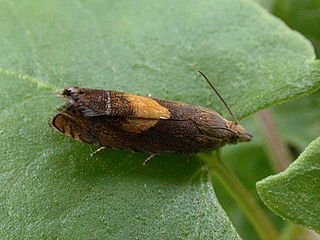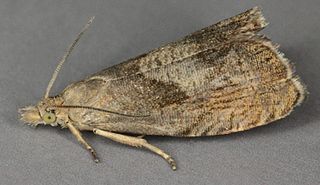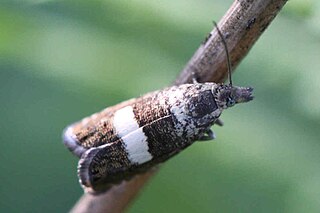
Tanacetum is a genus of about 160 species of flowering plants in the aster family, Asteraceae, native to many regions of the Northern Hemisphere. They are known commonly as tansies. The name tansy can refer specifically to Tanacetum vulgare, which may be called the common tansy or garden tansy for clarity. The generic name Tanacetum means 'immortality' in Botanical Latin, since tansy was once placed between the burial sheets of the dead to repel vermin.

Dichrorampha acuminatana is a moth of the family Tortricidae. It is found in Europe and the Near East.

Dichrorampha petiverella is a moth of the family Tortricidae. It is found in the Palearctic realm.

Dichrorampha simpliciana is a moth of the family Tortricidae. It is found in Europe and the Near East.

Argyresthia goedartella, the bronze alder moth, is a species of moth of the family Argyresthiidae.

Gillmeria ochrodactyla is a moth of the family Pterophoridae found in Asia and Europe. It was first described by the Austrian entomologists, Michael Denis & Ignaz Schiffermüller in 1775.

Dichrorampha is a genus of moths belonging to the subfamily Olethreutinae of the family Tortricidae.

Gillmeria pallidactyla is a moth of the family Pterophoridae first described by the English entomologist, Adrian Hardy Haworth in 1811. It has a Holarctic distribution and is widespread throughout North America and the Palearctic.

Dichrorampha heegerana is a species of moth of the family Tortricidae. It is found in central Europe, Sweden, Finland and Russia.

Depressaria olerella is a moth of the family Depressariidae. It is found in most of Europe, except Ireland, the Netherlands, the Iberian Peninsula and most of the Balkan Peninsula.

Dichrorampha alpinana, the broad-blotch drill, is a species of moth of the family Tortricidae. It is found in almost all of Europe.
Dichrorampha rilana is a species of moth of the family Tortricidae. It is found in Albania and Bulgaria, where it has been recorded from the Vitosha, Rila and Pirin mountains. The habitat consists of subalpine herbaceous formations on siliceous soils.

Dichrorampha vancouverana, the tanacetum root moth, is a moth of the family Tortricidae.

Dichrorampha aeratana is a moth belonging to the family Tortricidae. The species was first described by Pierce and Metcalfe in 1915.
Dichrorampha agilana is a moth belonging to the family Tortricidae first described by Johan Martin Jakob von Tengström in 1848.

Dichrorampha consortana is a moth belonging to the family Tortricidae. The species was first described by James Francis Stephens in 1852.
Dichrorampha flavidorsana is a moth belonging to the family Tortricidae subfamily Olethreutinae Tribe Grapholitini first described by Henry Guard Knaggs in 1867.
Dichrorampha incognitana is a moth belonging to the family Tortricidae. The species was first described by Jerzy Kremky and Maslowski in 1933.
Dichrorampha sylvicolana is a moth belonging to the family Tortricidae. The species was first described by Hermann von Heinemann in 1863.

Dichrorampha sequana is a species of moth belonging to the family Tortricidae.
This page is based on this
Wikipedia article Text is available under the
CC BY-SA 4.0 license; additional terms may apply.
Images, videos and audio are available under their respective licenses.















